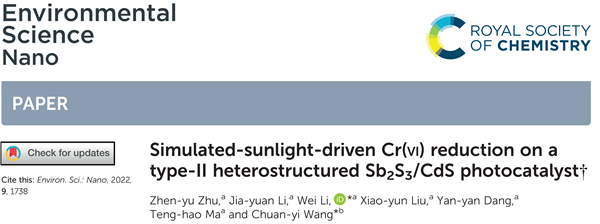Simulated-sunlight-driven Cr (VI) reduction on type-II heterostructured Sb2S3/CdS photocatalyst
writer:Z. Zhu, J. Li, W. Li, X. Liu, Y. Dang, T. Ma, C. Wang
keywords:Transition metal sulfides, Cr(VI) wastewater remediation, Simulated sunlight, Heterojunction, Photocatalysis
source:期刊
specific source:https://doi.org/10.1039/D2EN00050D
Issue time:2022年

Photocatalysis technology is a promising strategy to solve the pollution of Cr(VI) wastewater. Transition metal sulfides (TMSs) are identified as a kind of important photocatalytic materials, but they are easy to be photo-corroded under light-irradiation, resulting unstable photoactivity. Among TMSs, large-sized antimony trisulfide (Sb2S3) possesses prominent structural stability. However, long-periodic migration of body photo-carriers generally leads to high-frequent recombination behavior followed by low quantum yield. To address this challenge, CdS nanoparticles here were uniformly anchored on the surface of Sb2S3 nanorods to construct a heterostructured catalyst via a solvothermal method. Due to the formation of type-II heterointerface, body-to-surface photo-carriers? migration was boosted significantly, resulting obviously suppressed photo-carriers recombination and high photo-carriers utilization. Thereby, the stable and highly improved simulated-sunlight (SSL) driven photoactivity for Cr(VI) reduction was achieved on the optimized catalyst, exceeding that of bare Sb2S3 by ~138 times. Through regulating the pH value of Cr(VI) solution (pH = 2.0), the Cr(VI) ions can be completely converted to Cr (III) during 2 min, and excellent resistance ability to impurity ions and photostability were shown by this catalyst. This study broadens the application of Sb2S3 semiconductor in photocatalysis field and provides a feasible strategy for fast remediation of Cr(VI) wastewater.